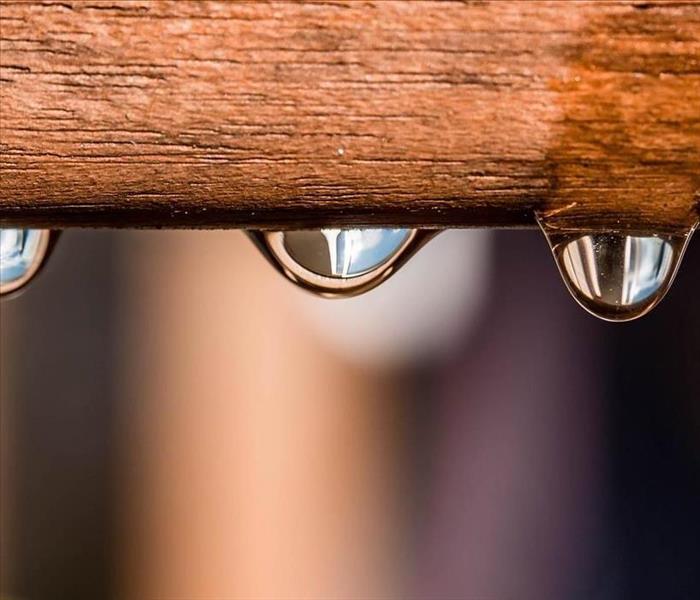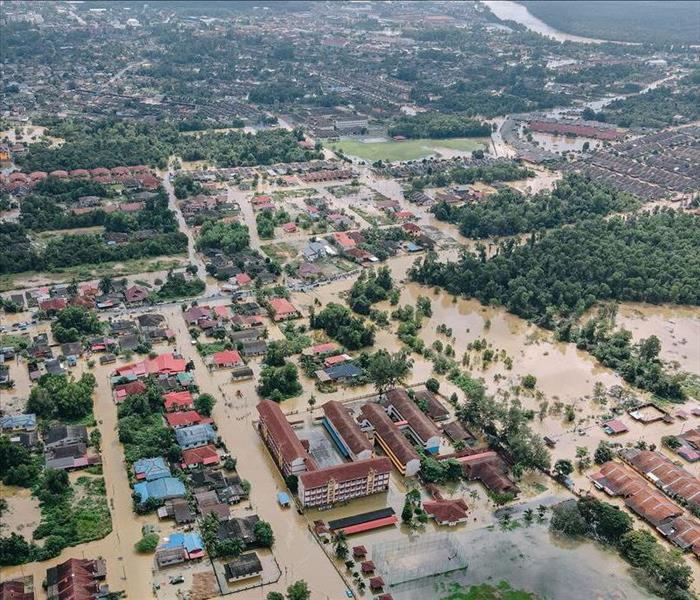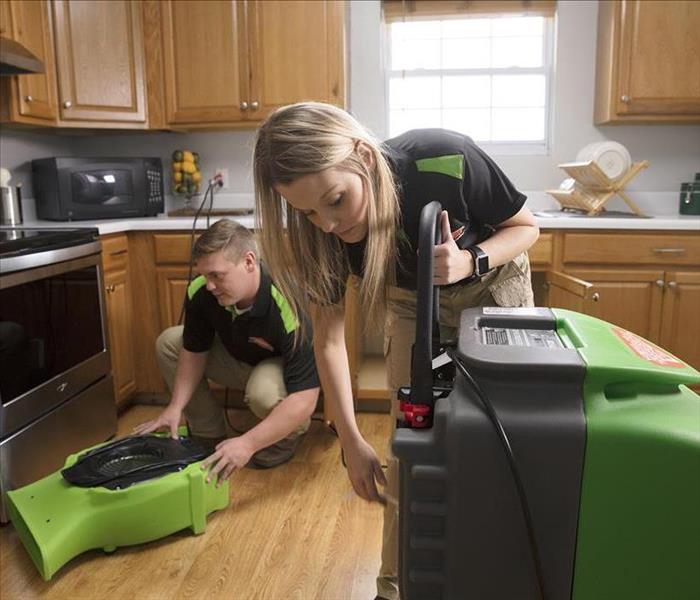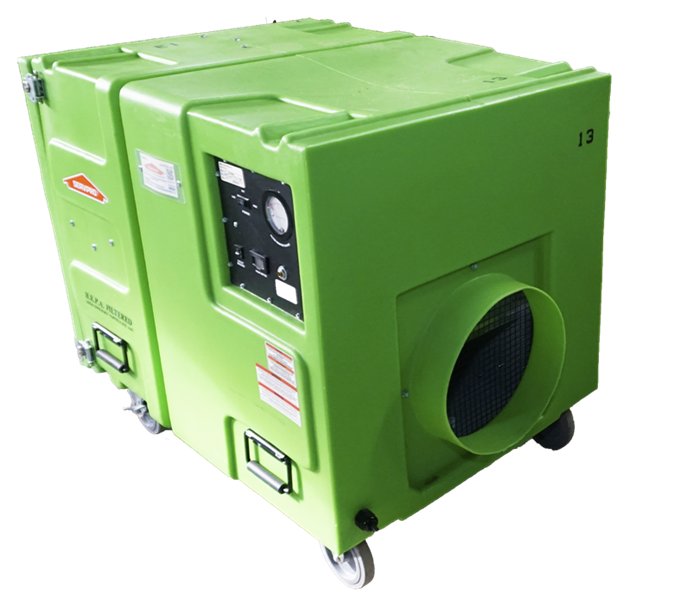Recent Water Damage Posts
Wet Carpet Restoration
9/19/2022 (Permalink)
When a building has water damage following a storm or other disaster such as a pipe break or appliance malfunction, it can affect carpeting throughout the space. Sitting, wet carpet may lead to concerns such as microbial growth, which is why hiring a team of SERVPRO professionals is the right decision. They’ll get the job done right while staying prompt and professional. Using fans, desiccants and dehumidifiers, SERVPRO of East Independence/Blue Springs teams will dry out the water from carpet and carefully examine atmospheric readings to determine moisture levels. Our reconstruction team can also aid in necessary construction services. To make water damage to your property seem “Like it never even happened,” do not hesitate to hire the team with the most expertise and efficiency, SERVPRO.
Wood Flooring Water Damage
9/9/2022 (Permalink)
 Call our SERVPRO team if you notice damage to your property.
Call our SERVPRO team if you notice damage to your property.
Here at SERVPRO of East Independence/Blue Springs, our team of professionals is always making sure to inspect spaces carefully for water damage. While some signs of water damage can go unseen, one indicator of damage is cupping or warping on a wood floor.
Cuppinglooks like the floor boards creating a concave shape with higher sides than the center. Cupping can occur when the underside of the boards gain moisture. Warpingtends to be more severe than cupping because it involves the floor buckling or popping off of the subfloor. Water vapors can cause this to happen.
A problem that can stem from neglecting to fix floors with moisture is the possibility of microbial growth. If this continues without restoration, it can permanently damage your floor.
If you see cupping or warping going on in your property, do not hesitate to contact SERVPRO of East Independence/Blue Springs to extract the moisture and remediate the damage.
Minimize Leaking Toilet Damage
9/8/2022 (Permalink)
A toilet leaking or overflowing can lead to water damage and possible containments in your residential or commercial space. A situation like this requires swift action and the right team doing the job. Luckily, SERVPRO of East Independence/Blue Springs offers emergency service 24 hours a day and is committed to making any situation “Like it never even happened.”
The supply line, which brings new water into the tank and is part of the flush mechanism, may become worn or cracked which leads to leaking. A malfunctioning flapper or valve could also be the culprit. If this happens in your property, make sure to turn off the water supply to prevent further damage. This can be found behind the metal supply line with the valve near the wall's connection point. Then, remove all the water in the tank.
Our SERVPRO team has the skills needed to handle a job of this type. We are able to safely clean the affected area and restore it after damage. We are Here to help!
Three Categories You Need To Know About Water Contamination
12/13/2021 (Permalink)
 Floodwaters can bring contamination due to the unknown source of water.
Floodwaters can bring contamination due to the unknown source of water.
Here at SERVPRO, we will always accept a job because we want to ensure we are always there for our clients. When approaching a job site with a relatively large amount of water, we must classify its category.
Category 1: "Clean Water"
Category one is when a leak comes from a clean source such as a toilet with no urine or feces. In this category, it's important to remember that it will progress into category two or three in this category. Our team will work as hard as possible to ensure that the category doesn't escalate.
Category 2: "Gray Water"
Contamination becomes a concern for our staff and the client during this step. We suggest that the client not enter or ingest any of this water because it can cause health effects.
Category 3: "Black Water"
We will tell our clients not to ingest this type as harmful pathogens that can create health effects with this category. This is because water from this source comes from an unsanitary source which means our crew will be wearing full hazmat suits to ensure their health and safety aren't compromised. This water is created from a source such as water from beyond the toilet trap, a toilet bowl with feces, or standing water that has microbial growth starting to grow.
Grab The Plunger! We Have A Problem!
12/13/2021 (Permalink)
 Bacteria Growth is widespread when a toilet is clogged. Use bleach to kill the bacteria, which will help eliminate the smell.
Bacteria Growth is widespread when a toilet is clogged. Use bleach to kill the bacteria, which will help eliminate the smell.
There is a huge health risk in your home, a clogged toilet because it's easy for microbial growth to start to grow. If someone procrastinates unclogging their bathroom, they risk the clogging getting worse. The paper parts will dissolve, and the solid parts will fill in the gaps, worsening the clog. Here are some of the concerns when you don't address toilet clogging.
Toilet Overflow
When people think about clogging a toilet, they will not flush it out of the fear of overflowing the bowl. Before writing this, I wasn't aware of this, but some toilets have a problem with a small leak into the bowl. This isn't enough for your eyes to notice, but it will seep up and overflow the bowl when left unattended for hours on end. When it floods, it is considered "black water," which runs the risk of contaminated water being spread throughout your bathroom.
Bacteria and Smells
The smell that is created within hours of a clogged toilet smells horrific. When you let a clog sit, you aren't just smelling the clog but also smelling microbial growth. This bacteria growth looks like a pink or red slimy substance forming in your toilet bowl. Bacteria growth smells like the awful scent of rotting eggs. To kill the smell, you should add a cup of household bleach, and you will want to add that down to the drain to kill the bacteria growth, which will help the smell.
Removing Moisture from Materials
11/16/2021 (Permalink)
 Our Project Manager will provide a precise outline of all the equipment that should be used.
Our Project Manager will provide a precise outline of all the equipment that should be used.
When our Project Manager comes to a job site affected by water, they will look at two factors: type of material and the degree of wetness. They will look at the variation of each material’s ability for water to pass through the material. In contrast, the degree of wetness refers to the moisture movement by finding out the water source. The liquid will be presented in one, two, or three forms.
Surface Water
This type of liquid can be found on the material’s surface, making it easier to find since it is a liquid, visible, and evaporates. When clearing this type of liquid from a material, it is essential to physically remove the moisture by using mechanical extraction equipment to ensure you get all moisture off the fabric. Our technicians will use different airflows, which help moderate the temperature and humidity, which helps evaporate the remaining water.
Free Water
You will find moisture within the material when approaching free water, but it hasn’t bonded with the chemical properties. The moisture can be found in cavities, open pores, and other air spaces within these materials. What’s different about free water compared to surface water is that you can see the moisture when the material is darkened. Similar to surface water, free water can be evaporated. When extracting this type of water, you will want to use lower humidities and warmer temperatures. By keeping it monitored, you are ensuring that you are maintaining the rate of evaporation.
Bound Water
Bounded water is different from the other types because this is when the liquid has bonded with the material’s chemical bonds. When trying to extract the moisture from the material, you will have to release it before evaporating. Controlling the airflow onto the fabric won’t be helpful, but it will dry fastest when it’s warmed. You must maintain the surrounding humidity very low with the liquid being chemically bonded with the material. It takes longer than the other two.
Knowing what separates each classification is just one component. Our Project Managers will know the best course of action that the technicians will carry out. This course of action will include how much of each piece of equipment will be needed to ensure the job gets done correctly.
Why do we install Air Filtration Devices (AFDs/ Air Scrubber) on water damage jobs?
9/20/2021 (Permalink)
 This is an Air Scrubber or known as an Air Filtration Device that is an essential piece of equipment for water damage restoration jobs.
This is an Air Scrubber or known as an Air Filtration Device that is an essential piece of equipment for water damage restoration jobs.
Why do we install Air Filtration Devices (AFDs/Air scrubbers) on water damage jobs?
- To provide the occupant with a cleaner, safer indoor in-door environment.
- Even clean-water losses are susceptible to compromised indoor air quality.
- The high-velocity airflow necessary for effective drying does more than evaporate moisture into the air—it also stirs up millions of microscopic particles that have been trapped in the carpet or have settled on structural materials.
- An air scrubber helps prevent these undesirable particles ….. from remaining in the indoor environment …..By greatly reducing the types and quantity of airborne particles, an air scrubber also reduces the chances that occupants or technicians will inhale contaminants…. – d. Source: Guide To Air Scrubbing https://www.legendbrandsrestoration.com/Fileshare/Documents/Guide-to-Airscrubbing.pdf
- To reduce the risk of spreading Covid 19. Using AFDs prudent step for all projects. Source: https://www.cdc.gov/coronavirus/2019-ncov/community/ventilation.html
Midwest Summer Drought
9/10/2021 (Permalink)
Midwest Summer Drought - The consequences of the Midwest drought have been insurmountable. The process of what happens is best described by this. When dirt is dry and clumped together it does not allow water to penetrate. When soil is damp, water can easily follow the path of least resistance and sink down to be absorbed. Soil absorbs moisture better when damp, acting like a sponge. What we've been seeing is that when it does rain or people use their hoses (to water lawns gardens, trees, etc.), the water has nowhere to go from the ground being so dry. In this situation, water ends up inside the home, easily flooding basements since the water followed the path of least resistance. We are fully prepared to help with your water damage during this summer drought.
How to Prevent Water Damage During a Drought
9/10/2021 (Permalink)
Normally, drought and water damage aren't synonymous words, but it is important to know how water damage can occur after bouts of dryness. Dry soil problems that could potentially damage your home's foundation can be slowed by using a soaker hose to provide a consistent, but not flooding, water source to the soil immediately surrounding the home’s foundation. Don't turn on your hose and leave it or forget it. You want to monitor the consistency of soil around your foundation. Being an active homeowner and taking a walk around your foundation is essential. Always make sure the gutter systems are connected and that water is directed away from your foundations. If you experience water damage at all during this drought, then you can call on our team to help!
5 Things That may Help Save Water Damaged Contents
8/20/2020 (Permalink)
A deluge in one’s home is a nightmare to think about, but water damage in a commercial building takes it to a whole other level. A flooded company can mean expensive electronics; mechanical systems and even employee jobs could be at peril. Fortunately in the Kansas City metro there are water remediation professionals who are trained to help you get through such a situation.
5 Things That may Help Save Water Damaged Contents
Not all hope is lost if you experience a flooded company property. There are some techniques and processes that may help save some of your contents.
- Drying – If flooding is fresh water from a broken pipe for instance, carpet, sheetrock, some furnishings, and even some documents may be saved by drying them out quickly.
- Sanitizing – Non-porous surfaces that did not absorb water may be cleaned using detergent and chlorine bleach to disinfect.
- Mold remediation – If mold is properly removed and destroyed there will be less chance of recurrence
- Odor Removal – Standing water, or items that were not dried quickly
- Dry cleaning – Certain contents such as draperies or other fabric items may be sent out for dry cleaning in order to clean and deodorize them.
It may require the use of commercial extraction equipment and industrial fans to thoroughly dry out the building itself including concrete, carpets, pads and walls. In addition a dehumidifier can help prevent the development of mold. Mold spores thrive in damp conditions and can develop quickly, dryness is critical.
Metal, plastics and certain other hard surfaces may be scrubbed and sanitized using bleach and detergent. Dry cleaning can save many non-washable fabric items. Ionizers and ozone machines can help dissipate and remove odors due to bacterial growth.
Understanding Water Types
8/20/2020 (Permalink)
When your home or business suffers a water damage, understanding what type of water you are dealing with is critical to ensuring proper cleanup.
There are three types of water.
- Clean water (Category 1) is water from a broken pipe or any other CLEAN water source; rainwater is also considered clean.
- The term gray water is used to classify slightly contaminated water (Category 2). Clean water becomes gray water when it is left untreated for too long, causing bacteria to other contaminants to begin growing, making the water hazardous.
- Black water (Category 3) is highly contaminated and filled with fungi, bacteria, chemicals, human waste and more. Black water is typically caused by sewage backup, storm flooding, or any other type of natural disaster. Black water should always be handled by trained professionals.
Consider taking the following precautions to help minimize damage or prevent further damage while waiting for SERVPRO of East Independence/Blue Springs professionals to arrive:
DAMAGE FROM CLEAN WATER
- Shut off the water source if possible or contact a qualified professional to do so.
- Turn off circuit breakers for wet areas of the building if access to the power distribution panel is safe from potential electric shock. Do not enter rooms with standing water, as electrical shock hazards may exist.
- Remove as much excess water as possible by mopping and blotting. Wipe excess water from wood furniture after removing lamps and tabletop items.
- Remove and prop up wet upholstery cushions to allow even more drying.
- Move any paintings, art objects, computers, documents and other valuable items that may be sensitive to moisture, to a safe place.
- Do not leave books, newspapers, magazines, or other colored items on wet carpets or floors as they may cause staining.
- Do not use your household vacuum cleaner to remove water. You will destroy your vacuum cleaner and will most likely cause electric shock in the process.
- Do not turn on ceiling fixtures if the ceiling is wet; do not enter rooms where ceilings are sagging from retained water.
DAMAGE FROM CONTAMINATED WATER
- Avoid all contact with sewage and items contaminated by sewage. Wash your hands THOROUGHLY if you come in contact with contaminated items.
- Do not walk through contaminated areas, as you could spread the damage to unaffected areas of the home or business.
- Do not turn on the HVAC system is there is a possibility of spreading contaminated air.
- Do not use household fans to dry the structure; air flow could spread contaminants.
- Discard any food and/or products for personal hygiene and cleanliness if exposed to the contaminated areas.
WHAT TO DO IF YOU NOTICE WATER DRIPPING FROM A LIGHT FIXTURE?
8/19/2020 (Permalink)
Water dripping from a ceiling light fixture can be an extremely dangerous and deserves immediate attention. That is because electricity and water can be a dangerous combination. Most people understand that water drips can come from their plumbing fixtures, but some don’t notice that it’s also possible to suffer a water leak in your light fixtures. To ensure your family’s safety here are steps can help you to safely resolve the issue.
- Utilities
Turn off the electricity. Water can conduct electricity from an active electrical line, and that can become a very dangerous situation as the current flows through the metal parts of the light fixture. Any contact with the electrical current from the fixture and the source of water can cause electric shock. To stay safe, better to turn off your electricity for home through the breaker box.
- Determine the Source of the Water
Once the electricity is off, try to figure out where the water is coming from. If the source of the water is a leaky pipe, you should turn off the water main valve to your home to prevent the spread of water. Leaving the water flowing can develop more ceiling damage.
- Draining
The Water dripping sometimes pool and cause protrusion in your ceiling. If that the case, you may consider draining the area.
- Have the Light Fixture Replaced
In order to replace the light fixture, first contact a professional water damage specialist to fix the leak. Once the water has been removed and the leak has been repaired, you should have an electrician replace the light fixture. Do not attempt to do the repair by yourself, you may end up making the problem worse and causing more damage or injuring yourself.
Water in a light fixture can be dangerous and can cause injury as well as damage to your house. Take every precaution and allow professionals to do the most important work.
If you notice a problem and need water damage restoration, here at SERVPRO of East Independence/Blue Springs we will provide trustworthy and effective water damage restoration services. Please call us (816) 224-5300.
Acquiring Water Damage Cleanup Services in Blue Springs
8/12/2020 (Permalink)
Water Damage Cleanup in Blue Springs provides you with complete cleaning services after a natural disaster, fire, or flood. These services include extraction of water, removal of all debris, and reconstruction of the affected areas. By utilizing these services, you receive fast response and effective services. Your local restoration service may file your homeowner’s insurance claim for you to save you time and avoid out of pocket costs. To learn more about these services, contact Professional Fire Restoration.
Restoring Your Home After a Natural Disaster
Your local restoration service offers you the chance to restore your home after a natural disaster. With these services, you receive complete water extraction from your entire home. Sanitation services are performed to ensure that all affected areas are properly cleaned and that there is not the presence of mold, mildew, or other pathogens in your property. Once these services are complete, a contractor will present you with floor plans for the reconstruction of these areas. You may choose the option that you prefer based on your homeowner’s insurance coverage and your personal preferences.
Local Restoration Services
Professional Fire Restoration provides you with water damage cleanup in Blue Springs and so much more. This service provider will address all affected areas after a complete inspection. The inspection assures that all affected areas are cleaned and sanitation services are performed. Their sanitation services ensure that mold, mildew, and or toxins do not develop within your property. They additionally offer complete reconstruction services of the affected areas.
For water damage cleanup in Blue Springs, you should consult your preferred provider immediately after a natural disaster. These fast services allow you to find an immediate solution to property damage sustained by storms or flooding. These events are detrimental to property owners and present the need for a service provider as soon as possible. If your home was damaged due to a natural disaster, clean up and remodeling services are covered through your homeowner’s insurance. To begin this process today, contact SERVPRO of East Independence/Blue Springs.




 24/7 Emergency Service
24/7 Emergency Service





